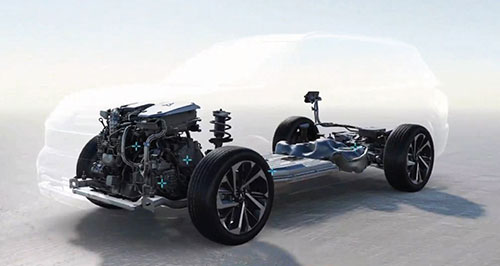Make / Model Search
News - Mitsubishi - Pajero SportMitsubishi’s PHEV-olutionJoin us for a deep dive into the technology behind Mitsubishi’s plug-in hybrid system10 Jan 2023 MITSUBISHI launched its second-generation Outlander PHEV in August, featuring a heavily revamped hybrid system, fresh visuals, and some added refinement.
With the improvements came a price increase for 2022, and the 2023 models again jump by between $1000 and $1500, starting at $55,590 and running up to $69,990 for the seven-seater top-spec Exceed Tourer.
The price increase did not deter buyers for the 2022 range, which sold out in a matter of weeks and given the size of the current waiting list, the 2023 Outlander PHEV line-up will prove no different.
Mitsubishi Motors Australia says it is pushing for more stock in 2023, when talking to media in a recent information session, compared with the 400 allocated Outlander PHEV models delivered in 2022.
“Our biggest issue is supply at the moment and we saw that when the 2022 model year Outlander PHEV was released – our allocation sold out within the first month,” said Mitsubishi Motors Australia e-mobility strategy manager Tim Clarke.
“We’re working really hard to triple or quadruple that allocation for the ’23 model year.
“As it stands at the moment, if we were to triple or quadruple that allocation, they would already be sold based on the waiting list.
“That tells us there is demand for the new Outlander PHEV in particular, and we would like to take the position as the leading PHEV brand in Australia.
“That’s our ambition for this product.”
Mr Clarke provided Australian media with a deep-dive into Mitsubishi’s latest PHEV system, including its ability to put electricity back into the grid.
The second-generation Outlander PHEV got a larger battery, improved cooling, stronger electric motors, larger fuel capacity and beefed-up powertrain components.
All of this equates to an improvement to the claimed electric-only driving range from 54km in the old model to 84km now, but the real magic lies in the delicate balance between electric and petrol operation and the system’s ability to modulate this based on driving conditions.
The system comprises a 20kWh lithium-ion battery pack, 85kW front-axle motor, 100kW rear motor, and 2.4-litre Atkinson cycle four-cylinder petrol engine producing 98kW, which acts mostly as an on-board generator but is also capable of driving the front wheels.
Mitsubishi’s latest PHEV system highlights the reality that electric motors are efficient for stop-start low speed use, while internal combustion engines are beneficial for high-speed cruising.
This delicate balance has been optimised for use in the Parallel Hybrid powertrain mode, which allows the petrol engine to power the front wheels via a single-speed transaxle from 70km/h and up.
The other two drive modes, EV and Series Hybrid, are more suited for 0-80km/h urban driving, where regular stop-start conditions enable the regenerative braking system to recover energy into the battery.
Series Hybrid mode uses the petrol engine as an on-board generator, while drive is delivered through the front and rear electric motors all the way from rest to the Outlander’s top speed.
Mitsubishi’s system decides on the optimal drive mode based on two factors; firstly it is always trying to switch off the ICE engine, and secondly it monitors the torque demand.
For example, the pure-electric EV mode will cancel when torque demand is too high, opting for one of the two hybrid modes.
The Outlander has a theoretical combined range of more than 850km. This is made up of the 800+km hybrid mode range and the 84km all-electric range. Two-way technology
The latest PHEV system from Mitsubishi offers flexible charging, with four modes that can be used to juice up the new Outlander.
Normal 240-volt AC charging, via a domestic power outlet, will take about 9.5 hours to reach 100 per cent charge. The fast-charge AC option (using a wall box) will take around 6.5 hours, and the rapid DC charging option will take just 38 minutes to reach 80 per cent charge.
On the move, a dedicated ‘Charge Mode’ diverts some energy from the petrol engine to charge the battery to 80 per cent in 94 minutes, for example enabling drivers to replenish the battery during a long highway or country road journey before switching to electric-only mode once an urban area is reached in order to reduce local noise and air pollution.
In addition, vehicle-to-load capability allows the use of two on-board power points, with an onboard 1500W, 240-volt AC inverter and the petrol engine’s ability to generate electricity for as long as there is fuel – for example in emergency situations and natural disasters where the PHEV can provide energy security by acting as a mobile power plant.
The vehicle-to-home and vehicle-to-grid functionality takes this even further, enabling the PHEV’s battery to power a building, or for example to store surplus solar energy for later usage.
Mitsubishi’s system is capable of 10kW maximum discharge rate with 20kWh storage capacity, while Charge Mode allows off-grid power generation using the petrol engine.
Owners can even operate their own microgrid, which makes profitable energy arbitrage possible. Charging the PHEV during off-peak times, then sharing energy back to the grid during peak times to profit, would in theory be possible with this system.
The system’s two-way potential is made possible by an Electric Vehicle Supply Equipment (EVSE) system, with vehicle-to-grid and vehicle-to-home functionality.
Mitsubishi Motors Australia is standing by this two-way technology and by 2023 expects to have bi-directional chargers turned on at its head office.
The two-way technology in Mitsubishi’s latest PHEV system has the potential to encourage the uptake of suburban microgrids, reducing grid dependence, lowering energy costs and supporting the energy ecosystem as demands grow due to electrification of the vehicle fleet and a move away from gas-powered hot water, heating and cooking appliances.  Read more |
Click to shareMitsubishi articlesResearch Mitsubishi Pajero Sport pricing
Motor industry news |












Facebook Twitter Instagram